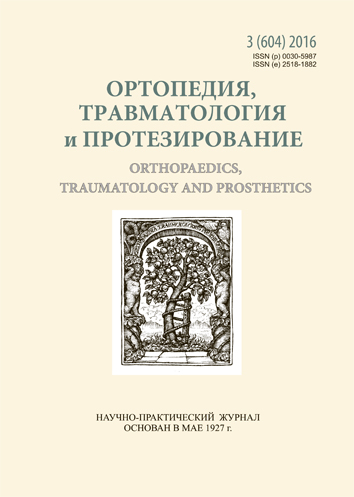Laboratory markers for the assessment of patients with posttraumatic coxarthrosis in preparation for hip joint arthroplasty
DOI:
https://doi.org/10.15674/0030-59872016373-77Keywords:
laboratory markers, post-traumatic coxarthrosis, joint replacement, biochemistry, interleukinsAbstract
For the evaluation of patients with coxarthrosis (CA), who recommended for hip replacement, it is necessary to apply comprehensive approach for the study of the functional state of organs and body systems, including the use of biochemical markers of mineral, protein and lipid metabolism.
Objective:to conduct a survey of patients with post-traumatic CA to detect metabolic disorders by means of laboratory markers and the predictability of complications after surgery. The study involved 35 patients (21 of men, 14 women) aged 30 to 80 years with post-traumatic CA stage IV. The control group consisted of 30 healthy people (13 men, 17 women) aged 27 to 50 years. In the serum of patients, total protein, albumin, glycoproteins, sialic acid hondroyitynsulfats, haptoglobin, glucose, total cholesterol, triglycerides, ALT, AST, alkaline and acid phosphatase, HHTP, thymol, fibrinogen, interleukin IL-1, IL-4, IL-6 and circular immune complexes have been determined.
Results: patients with post-traumatic CA had two-fold increased levels of fibrinogen and glycoproteins in serum, sialic acid decreased by 52,2 %, haptoglobin - by 26 % globulins - by 19.6 %, cholesterol -by 23.9 %, triglycerides -by 46.4 %, thymol test -2.2 fold, IL-1 -three-fold, IL-6 -6 ti and IL-4 -2.2 times, the activity of alkaline phosphatase -by 75.7 %, acid -25.1 % and HHTP -47.8 % compared to the control group.
Conclusions: The increase in markers of acute phase in serum and activity of marker enzymes demonstrates the destructive inflammatory process in patients with a course of post-traumatic CA. The increase in cytokines and circular immune complexes is the evidence of increased immune reactivity due to the severity of the pathological process in joints, and it dictates necessity for careful monitoring after arthroplasty and pharmacological therapy to reduce the risk of complications in this category of patients.References
- Koshkareva ZV, Dmitriev LA, Rodionova LV, et al. Complex approach for the assessment of the functional state of some of the organs and systems of patients with dysplastic coxarthrosis genesis in hip arthroplasty. Bulletin ESSC SB RAMS. 2006;4(50):133–137.
- Dryagin VG, Istomin SY, Voronkov MY, et al. Biochemical aspects of aseptic loosening of total hip implants following total hip arthroplasty for coxarthrosis. Bulletin of South Ural State University, a series of «Education, health care, physical culture». 2010;19(23):55–59.
- Dryagin VG, Kurzov LG, DB PRSPs, et al. Influence of different types of surgical treatment on the activity of lipid peroxidation and antioxidant defense system in elderly patients with fractures of the femoral neck. Bulletin of South Ural State University, a series of «Education, health care, physical culture». 2012;21(31):101–104.
- Drez DJ, Finney TP, Roberts TS. Sepsis in orthopedic surgery. Orthopedics. 1991;14(2):157–162.
- Usoltsev IV, Shenderov VA, Nikiforov SB, et al. Total hip replacement: an experimental aspect of solving problems. Bulletin ESSC SB RAMS. 2008;4(62):80–84.
- Karjakin EV, Persova EA, Gladkov EV. The possibility of using laboratory predictors in assessing the development of aseptic loosening in total hip arthroplasty. Saratov Journal of Medical Science. 2011;7(2):437–441.
- Worthington T, Dunlop D, Casey A, et al. Serum procalcitonin, interleukin-6, soluble intercellular adhesin molecule-1 and IgG to short-chain exocellular lipoteichoic acid as predictors of infection in total joint prosthesis revision. Br. J. Biomed. Sci. 2010;67(2):71–76.
- Dryagin VG, Atmansky IA, DB PRSPs, et al. Dynamics of immunological status in elderly patients with osteoarthritis before and after total hip. Herald of Ural Medical Academic Science. 2012;2(39):20-21.
- Schwarzkopf R, Manzano G, Woolwine S, Slover J. Salvage treatment of hip fractures after failure of surgical fixation: a systematic review. Orthopaedic Knowledge Online Journal. 2015;13(3). doi: 10.5435/OKOJ-13-3-3.
- Morozenko DV, Leontievа FS. Methods of study of markers of connective tissue metabolism in clinical and experimental medicine. Young scientist: a scientific journal. 2016;2(29):168–172.
- Kamyshnikov VS. Clinical and biochemical laboratory diagnostics. Handbook 2 v. V. 1. Minsk: Interservice. 2003. 495 p.
- Karpishchenko AI. Medical laboratory technology and diagnostics. St. Petersburg, Intermedika, 1999;2:307.
- Glantz S. Biomedical Statistics: Per. from English. M.: Practice, 1998. 459 p.
Downloads
How to Cite
Issue
Section
License
Copyright (c) 2016 Stanislav Bondarenko, Volodymyr Filipenko, Frieda Leontyeva

This work is licensed under a Creative Commons Attribution 4.0 International License.
The authors retain the right of authorship of their manuscript and pass the journal the right of the first publication of this article, which automatically become available from the date of publication under the terms of Creative Commons Attribution License, which allows others to freely distribute the published manuscript with mandatory linking to authors of the original research and the first publication of this one in this journal.
Authors have the right to enter into a separate supplemental agreement on the additional non-exclusive distribution of manuscript in the form in which it was published by the journal (i.e. to put work in electronic storage of an institution or publish as a part of the book) while maintaining the reference to the first publication of the manuscript in this journal.
The editorial policy of the journal allows authors and encourages manuscript accommodation online (i.e. in storage of an institution or on the personal websites) as before submission of the manuscript to the editorial office, and during its editorial processing because it contributes to productive scientific discussion and positively affects the efficiency and dynamics of the published manuscript citation (see The Effect of Open Access).














